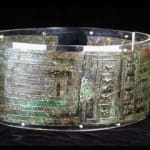Urartian Bronze Belt, 800 BCE - 700 CE
Bronze
13.25 x 5.5
FZ.214
The kingdom of Urartu, originally a confederation of numerous tribes from Eastern Anatolia, was one of the most powerful states in the Ancient Near East during the first half of...
The kingdom of Urartu, originally a confederation of numerous tribes from Eastern Anatolia, was one of the most powerful states in the Ancient Near East during the first half of the first millennium BC, constituting one of the fearest rivals of the Assyrian Empire. It was in the 9th century BC under Shalmaneser III (858-824) that the Urartian state developed a centralised system with several interconnected palace-fortresses placed on high rock outcrops.
Yet our knowledge of Urartian culture and history is mostly based on epigraphic evidence found especially in the area of Lake Van and in the Assyrian chronicles. From these sources, we know that during the 8th century BC Urartu expanded from Northern Turkey and Armenia, into Azerbaijan, Kurdistan and the Euphrates region, eventually coming into friction with the Assyrians and the Persians. Most of their military campaigns were indeed aimed at acquiring silver, copper and iron ores for their intensive metal-smithing industry.
When observing the military paraphernalia, such as helmets, quivers, and belts, the decoration undoubtedly provides important clues on the life and beliefs of the Urartian people during the two hundred and fifty years of existence of their kingdom,especially considering the paucity of alternative sources of archaeological evidence.
Although quite extensively produced, belts were in fact manufactured only for a period of one and a half centuries. Yet, belts like the one here illustrated, only ornamentally decorated, were probably produced and used over a long period of time. The hammered sheet metal, worked out from the back by punching, presents an outer surface decorated over its entire length with bands of seven rows of zigzags, framed by raised lines. This style is dated to the time of Sarduri II (760-730 BC) by an exceptional belt in the museum of Alanya with a cuneiform inscription bearing his name.
This magnificent belt originally encircled the waist of a warrior or a nobleman. Covered with a bold abstract geometry, the belt also features eight panels at the front depicting galloping horsemen. An emblem of rank, power and worldly stature, this superb belt eloquently evokes a vanished way of life.
This beautiful ceremonial belt, perforated along the borders to attach a leather lining and originally fastened with a leather strip tied to the small loop at the front, in terms of décor and technique represents one of the finest and most informative, yet un-deciphered remains of the material culture of the Urartian kingdom during its political apogee.
Yet our knowledge of Urartian culture and history is mostly based on epigraphic evidence found especially in the area of Lake Van and in the Assyrian chronicles. From these sources, we know that during the 8th century BC Urartu expanded from Northern Turkey and Armenia, into Azerbaijan, Kurdistan and the Euphrates region, eventually coming into friction with the Assyrians and the Persians. Most of their military campaigns were indeed aimed at acquiring silver, copper and iron ores for their intensive metal-smithing industry.
When observing the military paraphernalia, such as helmets, quivers, and belts, the decoration undoubtedly provides important clues on the life and beliefs of the Urartian people during the two hundred and fifty years of existence of their kingdom,especially considering the paucity of alternative sources of archaeological evidence.
Although quite extensively produced, belts were in fact manufactured only for a period of one and a half centuries. Yet, belts like the one here illustrated, only ornamentally decorated, were probably produced and used over a long period of time. The hammered sheet metal, worked out from the back by punching, presents an outer surface decorated over its entire length with bands of seven rows of zigzags, framed by raised lines. This style is dated to the time of Sarduri II (760-730 BC) by an exceptional belt in the museum of Alanya with a cuneiform inscription bearing his name.
This magnificent belt originally encircled the waist of a warrior or a nobleman. Covered with a bold abstract geometry, the belt also features eight panels at the front depicting galloping horsemen. An emblem of rank, power and worldly stature, this superb belt eloquently evokes a vanished way of life.
This beautiful ceremonial belt, perforated along the borders to attach a leather lining and originally fastened with a leather strip tied to the small loop at the front, in terms of décor and technique represents one of the finest and most informative, yet un-deciphered remains of the material culture of the Urartian kingdom during its political apogee.



